Menus
- 115 cm³ scooter for the racetrack
- The test machine is a replica of the original
- "You experience hell in the braking zones"
- From the racing history of Laing and his F50
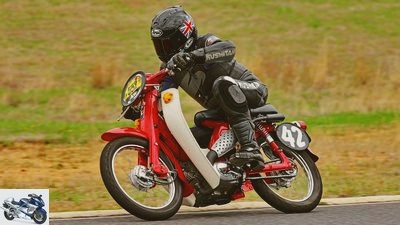
Piper
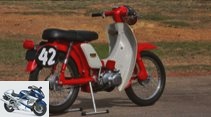
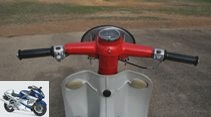
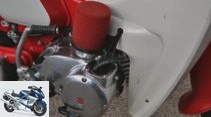
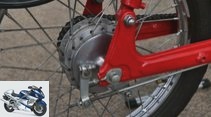
15th photos
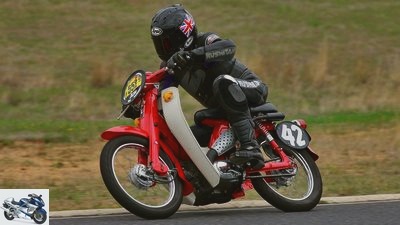
Stephen Piper
1/15
The Suzuki F50 in the driving report on the Boradford race track at the annual Bike Bonanza.
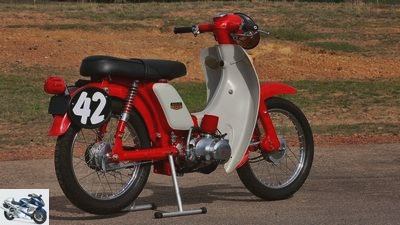
Stephen Piper
2/15
The Suzuki F50 weighs in at just 67 kilograms.
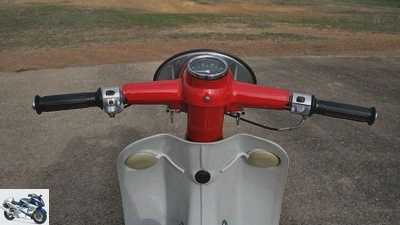
Stephen Piper
3/15
With this command center, Greame kept the competition at bay.
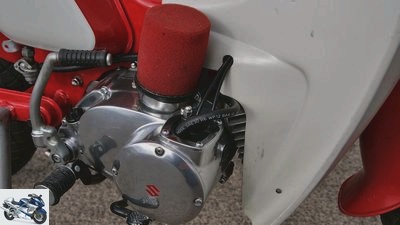
Stephen Piper
4/15
The rotary vane motor sucks into the crankcase, a thick filter protects the interior of the motor.
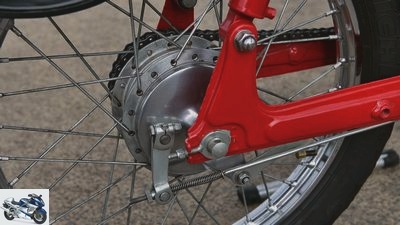
Stephen Piper
5/15
Only a marginal rear brake.
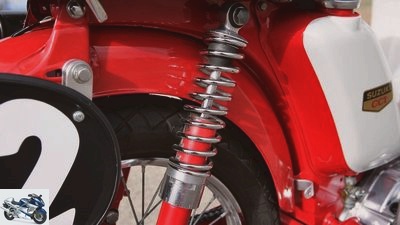
Stephen Piper
6/15
The shock absorbers come from the aftermarket, Suzuki recommended Girling at the time. This looks more like converted Konis.
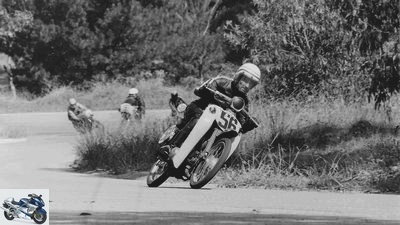
Jim Scaysbrook
7/15
Up front: Graeme Laing in the 1970s in the Australian 125cc championship.
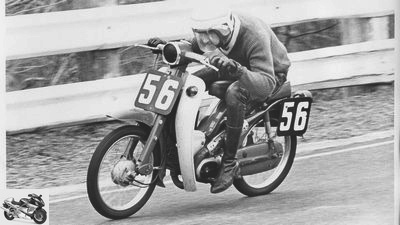
Jim Scaysbrook
8/15
Crass outfit: after suits and ties were banned, he wore a sweater.

Jim Scaysbrook
9/15
Peter Hagan’s Yamaha pursued by Greame Laing in Sandown Park in 1972. A short time later, Hagan falls and knocks them both to the ground.
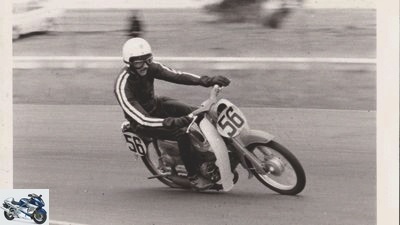
Jim Scaysbrook
10/15
Graeme Laing’s first ride on the super pull-through Suzuki in Calder 1970.
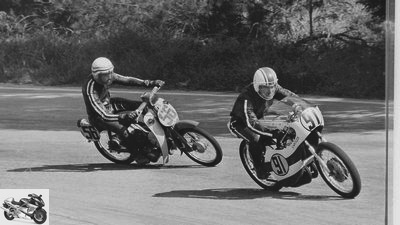
Jim Scaysbrook
11/15
Grame Laing rushes Con Withlock’s 125cc Yamaha, 1972.
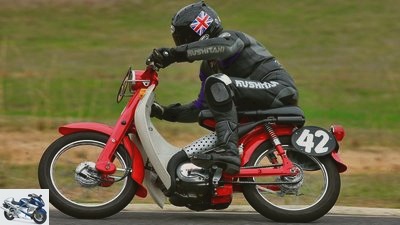
Stephen Piper
12/15
Incredible, i.e. ultra-nervous handling.
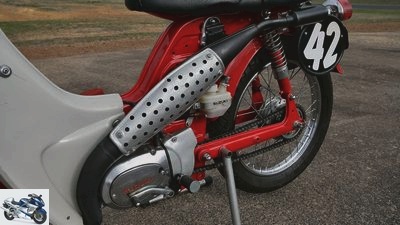
Stephen Piper
13/15
The exhaust runs the entire length of the machine.
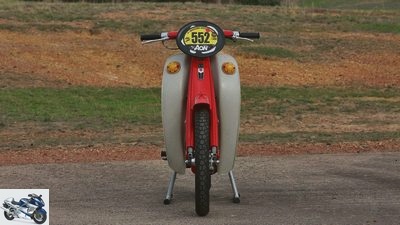
Stephen Piper
14/15
Almost everything on this F50 is still original production material. Only the lamp and the rear fender were replaced.
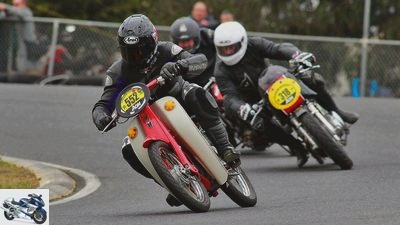
Stephen Piper
15/15
Thanks to the long first gear, you immediately lose 5 seconds at the start that you have to catch up in the corners.
Suzuki F50 in the driving report
115 cm³ scooter for the racetrack
Imagine turning the first corner with a 125cc Grand Prix Yamaha in front of the entire field – and then suddenly being slowed down by a Suzuki scooter with a pilot sitting upright. Graeme Laing does it with his 115 cc Suzuki hell racer.
W.If you dare to hit something really different on the race, it’s unlikely to be effective if you put it up front. And if you want to get known, it can even pay off twice. For Graeme Laing, the founder and head of the Melbourne Motorcycle Company, that was clear. As a major dealer in Suzuki motorcycles, he wanted to use both aspects of racing to show the potential of the Japanese brand, which until then had been rather poor compared to Honda and Yamaha. Until the appearance of the T500 with its air-cooled parallel twin in 1968, Suzuki only built the 250 T20, in addition, the brand had no sporting references in Australia. Laing wanted to change that.
Buy complete article
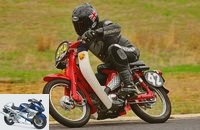
Suzuki F50 in the driving report
115 cm³ scooter for the racetrack
Getting a Suzuki A100 ready to race
In 1969, Laing hired Peter Jones as his mechanic and service manager. Jones was a successful racing driver himself and had a lot of experience with Suzuki racing machines. He helped his boss with the further development of his A100, a Suzuki single-cylinder two-stroke engine that, with a rotary valve inlet and a Suzuki racing kit, produced 17 hp from 98 cubic meters, almost twice as much as the production machine. The racing kit was quite elaborately designed: cylinder with revised channels, new control disk, new cylinder head, a larger 20 mm Mikuni carburetor, improved pistons, CDI ignition and a racing bulb. Peter Jones asked Graeme Laing to ask Suzuki whether there could be an increase in displacement to 125 cubic meters. But Suzuki replied: “The engine was not developed for 125 cc and racing.” What to do? Graeme did not give up and asked again whether he could at least install a 54 piston in order to be able to achieve 115 cubic meters. “The standard cylinder cannot be used for this, but we can supply you with two special cylinders that have a thicker cylinder liner.”
So Suzuki did help and had some advice on how to improve the handling of the A100. The swing arm bearings should be made of metal instead of plastic, and there were even spare part numbers for them. At the same time the recommendation came: “Our dealer in Venezuela successfully improved the handling by using a fork from Ceriani and shock absorbers from Girling.” Aha, Graeme Laing was not alone with the idea of making an A100 race-ready …!
The test machine is a replica of the original
However, Graeme’s main focus was on the engine. After he fitted the piston ring locking pins in the correct place in the Wiseco piston, the whole thing fitted together. And in fact, the good road A100 became a very successful 125cc racer. The increase in performance and three years of experience with the small single-cylinder ultimately led to some good placements. A win in Hume Weir in 1970, where he even beat Len Atlee at the CSD Yamaha, a second place in Winton, where he came in behind Bill Horsman and his lightning-fast TSS125 Bultaco.
Stephen Piper
The Suzuki F50 weighs in at just 67 kilograms.
The test machine here in the photos is a replica of the original. It was set up by Peter White: “I saw the Suzuki on the racetrack for the first time when I was 14 years old. And since then I’ve always wanted to build one. ”In 1993 he finally found an F50, which he put aside. After a motorcycle accident, he then had time to prepare the step-through scooter for the racetrack. He has been taking part in historic races since 2005.
For such a completely unsuitable machine, the pass-through Suzuki has quite a few standard parts: “It still has the original suspension and brakes. Even the brake pads in the standard drum brake of the F50 are series material. I even left the speedometer drive, the speedometer even works. The fairing is original, all I swapped is the lamp and the rear fender. It has a racing cylinder and a narrower gearbox. However, the first gear is so long that you lose five seconds at the start. You then have to make up for that in the corners. After all, the machine only weighs 67 kilograms, which is less than me! “
"You experience hell in the braking zones"
Okay, she weighs less than me too. Peter gives me the racer for 15 laps on the 2.16 kilometer Broadford racetrack for the annual Bike Bonanza. And I have to say, for the first few laps I laughed out loud into my Arai helmet. I’ve driven some weird machines in my long life, but I’ve never driven such an impossible vehicle as this super-step-through Suzuki F50. It is not the issue that the part was built for everything, except for the racetrack. It’s absolutely amazing how well she manages it anyway. It’s unbelievable how I overtake a Norton Manx that is twice as powerful on the outside, but it also weighs twice as much. The 115 PS will clearly surpass the 17 hp that the US brochure specifies for the 98 cm³ racing kit. There is no tachometer, but I think I should change gears at what feels like 8,000 rpm. Always keep a finger on the smooth clutch on the straight, in case something should go wrong in the racing engine. You only have to tap the gear lever on the left with your shoe, and the transmission shifts to the next level. First gear is actually very long, you have to let the clutch slip for a long time. The top three courses of the four-course box are tightly spaced. The only instrument is the original speedometer, which stops at 100 km / h. The needle is there for most of the lap!
You experience hell in the braking zones. The Suzuki slows down, braking cannot be called the marginal delay. And after slowing down three times, the fading begins. The handling is unbelievable, or shall we say, extremely nervous. But after a few laps I grooved myself in. You just have to forget that you are riding a step-through scooter. Then it works, but always with a smile.
From the racing history of Laing and his F50
After Laing had made a small 115 cc Suzuki A100-2 quite competitive, he came up with the idea of using the Suzuki F50 in the 125 cc class in 1971. He simply built the tuned A100 engine into the scooter.
Jim Scaysbrook
After extensive factory tuning, the Suzuki F50 was quite competitive. The Australian Graeme Laing used it in the 125cc championship.
In an interview with the magazine “REVS” he said: “If you can’t win, at least make a big show!” But on this really unusual machine, Graeme managed both. He drove his first races in unusual clothing, sometimes with a suit and tie over the leather suit. After the organizer and spectators protested, he only drove in a sweater at most. In the following years the Suzuki mutated into a crowd favorite, and Graeme had a lot of fun with the step-through scooter. The F50 was competitive enough to make it into the top five on a regular basis, even when the much more powerful Yamaha AS3 twins and the later TA 125 customer street racers made the A100 rotary valve two-stroke appear too weak. But it was extremely stable with only two failures in total. Unfortunately, once he fell in the rain, and once he ran over a driver who had fallen in front of him and lay down in solidarity.
Maintenance was easy: a change of piston rings and a new break contact were all the engine needed to freshen up. The great advantage was the incredible handling thanks to the ultra-short wheelbase of just 1040 millimeters. Even the original brakes were sufficient for racing.
Related articles
-
Suzuki GSX-R 1000 R in the PS driving report
Suzuki 14 pictures Suzuki 1/14 With the 2017 version, the GSX-R 1000 enters the sixth generation. The superbike rolled out for the first time in 2001, the …
-
Driving report Suzuki TL 1000 S
Driving report, Suzuki TL 1000 S Suzuki TL 1000 S. The TL 1000 S is intended to break the Italian supremacy among large-volume two-cylinder engines and…
-
Driving report BMW C1 Less risk, more fun Who says there is no fun without risk? As safe as a small car, says BMW, the new 125cc scooter is …
-
Driving report Yamaha WR 400 F
Driving report Yamaha WR 400 F Light and cross With the WR 400 F, derived from the new Moto Cross model YZ 400 F, Yamaha wants to enduro …
-
Driving report: Yamaha YZ 450 F
Ratering Driving report: Yamaha YZ 450 F Track test Factory Yamaha 450 Motocross Leaving the well-trodden path is currently popular in off-road technology ….
-
Ducati driving report Ducati GT 1000 The first and the last Inspired by the past: The GT 1000 bows to the first series Duc with …
-
Driving report KTM 400-520 EXC Racing
Driving report KTM 400/520 EXC Racing Take it easy Less can also be more. With the new, feather-light four-stroke sports enduro, KTM immediately landed a…
-
Driving report Harley-Davidson XR 1200
Jahn 15th photos HD 1/15 HD 2/15 HD 3/15 HD 4/15 HD 5/15 HD 6/15 HD 7/15 HD 8/15 HD 9/15 HD 10/15 HD 11/15 HD 12/15 HD 13/15 HD 14/15 HD 15/15 Driving…
-
Driving report Honda SP-1 Superbike
Driving report Honda SP-1 Superbike We can do it differently Honda is pushing for the Superbike crown with power and is attacking with a two-cylinder for…
-
Driving report Honda VTR 1000 time shift Japan is eight hours ahead of Germany, Honda is four weeks behind Suzuki – at least when it comes to the first…